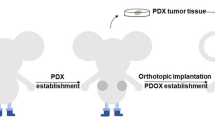Abstract.
The combined use of anti-angiogenic therapy (AT) and radioimmunotherapy (RIT) may improve the therapeutic outcome in patients with cancer lesions. This hypothesis is based on the ability of AT to suppress tumour endothelial compartments and the direct action of RIT against tumour cells. We previously confirmed this hypothesis in an established subcutaneous xenograft model of colon cancer. The purpose of the current investigation was to determine the benefit of this combination within a liver metastasis model, which mimics treatment of minimal disease in an adjuvant setting. Liver metastases were established in nude mice by intrasplenic inoculation of LS180 colon cancer cells; following such inoculation, metastases of <1 mm in diameter can be observed at 1 week and these lesions can attain a size of several millimetres at 2 weeks. Daily AT with 2-methoxyoestradiol (2-ME), 75 mg/kg, was initiated at 1 week. RIT with 7 MBq of 131I-A7, an IgG1 anti-colorectal monoclonal antibody, was conducted at 2 weeks. RIT employing an irrelevant IgG1, 131I-HPMS-1, was implemented for comparison. The weight of liver metastases was measured 4 weeks after cell inoculation. The effect of AT on 131I-A7 accumulation in metastases was also observed. Toxicity of treatment was monitored by blood cell counts. Monotherapy with 2-ME AT or 131I-A7 RIT significantly suppressed metastasis growth (P<0.0001): metastasis weight was 5.96±0.87 g in non-treated controls, 2.67±1.89 g in cases receiving AT and 0.85±0.68 g in those receiving 131I-A7 RIT. Combination of AT and 131I-A7 RIT more effectively suppressed the growth to 0.28±0.32 g (P<0.05 vs RIT alone). The effect of 131I-HPMS-1 RIT, which suppressed metastasis growth to 2.25±0.88 g, was significant in comparison with the control (P<0.0001); however, the combination of AT and 131I-HPMS-1 RIT (which suppressed growth to 1.41±0.68 g) was far less effective than the combination of AT and 131I-A7 RIT. AT did not decrease 131I-A7 accumulation in metastases. AT did not affect RIT myelotoxicity. The results of this study demonstrating the combined effects of AT and 131I-A7 RIT in a small metastasis model indicate that such combination therapy may be suitable for the treatment of minimal disease.
Similar content being viewed by others
Author information
Authors and Affiliations
Additional information
Electronic Publication
Rights and permissions
About this article
Cite this article
Li, XF., Kinuya, S., Yokoyama, K. et al. Benefits of combined radioimmunotherapy and anti-angiogenic therapy in a liver metastasis model of human colon cancer cells. Eur J Nucl Med 29, 1669–1674 (2002). https://doi.org/10.1007/s00259-002-0997-9
Received:
Accepted:
Issue Date:
DOI: https://doi.org/10.1007/s00259-002-0997-9




